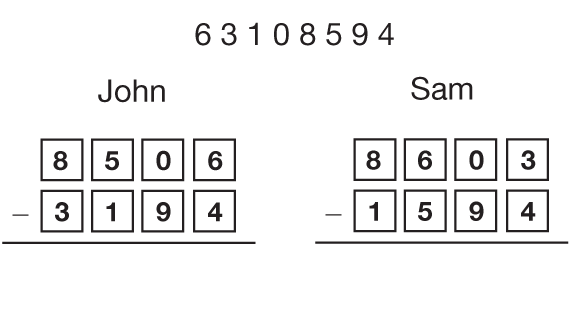Teacher: Let's talk about our strategies for placing the digits where we did. First, when subtracting, do you have to think about anything different than when adding?
Jacob: Yes, the top number has to be bigger than the bottom number, or else you can't subtract. The answer would go below zero.
That's right, Jacob, you would have a negative number for your answer and we're not dealing with negative numbers yet. For this game you would have already lost, because you wouldn't be able to subtract your bottom number from your top. So what do you do to make sure you can subtract, Shannon?
Shannon: If I get a large number, I better put it in the top number.
Teacher: Where in the top number, which place?
Keenya: You'd have to put it in the thousands place to make it a big number. If you put it in either of the other three places, you might have to put a little number in the thousands place and that would make it a small number.
Teacher: That's right, Keenya. It is the thousands place that matters first, isn't it? Now, looking at John's and Sam's game boards, I notice that both boys placed the first number 8, in the thousands place for the top number. Can you each explain your thinking?
John: Eight is one of the biggest numbers you can get. I did not want to take a chance that I would get the nine so I put it in the thousands place.
Sam: I thought it was a big number too, so I also put it in the thousands place of the top number.
Teacher: How did you decide where to place the three on your boards?
John: I was thinking that 3 is a pretty small number and I was not sure if I would get a smaller one so I put it in the thousands place of the bottom number.
Sam: I knew that the 3 was a small number but I also thought that since there were 6 more cards to be drawn there was a good chance that I would get something smaller so I put it in the ones place of the top number.
John: I should have thought more about that. I didn't think about the numbers that were left to be drawn.
Teacher: Why does the number in the thousands place of the bottom number have to be little?
Ana: Since you want the largest difference you need a small number in the thousands place.
Teacher: Good. Sam and John, can you explain why you placed the one where you did?
Sam: One is a very small number so I decided to place it in the thousands place of the bottom number. I did not want to take a chance that I would get a smaller number since zero is the only smaller number.
John: Since I had already placed the 3 in the thousands place of the bottom number I put the 1 in the hundreds place so I could keep that number as small as possible....
Teacher: Did anyone use a mental math strategy to solve their problem?
John: I did. I thought about moving up 6 from 3194 to 3200 on a number line. Then I moved another 5300 to 8500, and finally I moved up 6 more to 8506. Then I add 6 + 6 + 5300 = 5312.
Teacher: Good thinking. Who else can share a mental math strategy they used?
Sam: I used convenient numbers. First I subtracted 8600 − 1600 = 7000. Then I added 9 more to make my answer 7009.
Teacher: Sam, can you explain why you added 9 to your first answer?
Sam: When I changed 1594 to 1600 I had to add 6 to the bottom number and when I went from 8603 I had to subtract 3 from the top number. When I added the 6 and 3 together it made 9 that had to be added to the answer.
Teacher: Good thinking. What are some other strategies that were used?













